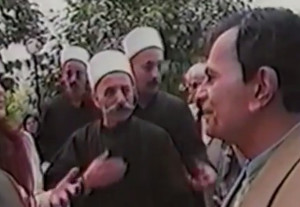Late as usual, I thought I’d still write up my own recollection of the legendary radio hit-meister Casey Kasem. Paul Riismandel has a great reminiscence of him posted last week. As for me, I always experienced Kasem’s Top 40 Countdown as a dreary auto-pilot affair, served up with a canned voice and a canned smile.
Then, in 1982, Israel invaded Lebanon and I learned that the mighty Casey was a human being. There he was on television, not hyping the latest hit by Foreigner, but speaking at a demonstration in San Francisco and denouncing the assault that would culminate in massacres of Palestinians at the Shabra and Shatila camps in Beirut.
“You wind up with 20,000 dead Lebanese and Palestinians, 40,000 maimed and 150,000 left homeless,” Kasem later told People magazine. “That’s when my shoe was stepped on. All of a sudden, that was really close to home.”
Suddenly he had my attention.
Casey Kasem was born Kemal Amen Kasem in Detroit in 1932. His parents were Lebanese Druze—that is, they counted among the estimated 250,000 adherents of the Druze religion, most of whom live in Lebanon with smaller groups dwelling in Syria and Israel.
Kasem was acutely aware of the demonization of Arabs in American culture. In an oft given speech, he recalled the day that his son Mike approached him and declared, “Dad, I hate Arabs.”
Kasem asked why. “Mike said it was because of what he saw in films and on TV,” he recalled:
“As a student at Detroit’s Wayne State University, I’d learned how media stereotypes can create public attitudes. But that lesson only hit me emotionally when I saw how it had affected my son’s self-image. I became more aware of how traditional Arab stereotypes get full play: from Rudolph Valentino’s 1921 portrayal of The Sheik (with its memorable line, ‘When an Arab sees a woman he wants, he takes her’); to bad Arabs with big swords pursuing everyone across the desert, from The Three Stooges and Hope & Crosby to Beatty & Hoffman; all the way to recent films, where Arabs appear only as terrorists. At the same time, the positive contributions of Arabs throughout history — and of the Arab-American community — are skipped over as if they didn’t exist.
That imbalance creates racism.”
Kasem wrote a pamphlet in 1990 titled Arab Defamation in Media: Its consequences and solutions. Seven years later, in celebration of the US lifting a travel ban to Lebanon, he visited his extended family in Moukhtara, his father’s native town.
I could not possibly imagine the existence of this person as I listened to his Countdown in 1982. It was as if a single individual functioned in two parallel universes. I wonder what kind of sea change in our media and society would have to take place to allow people such Casey Kasem to live in just one.



